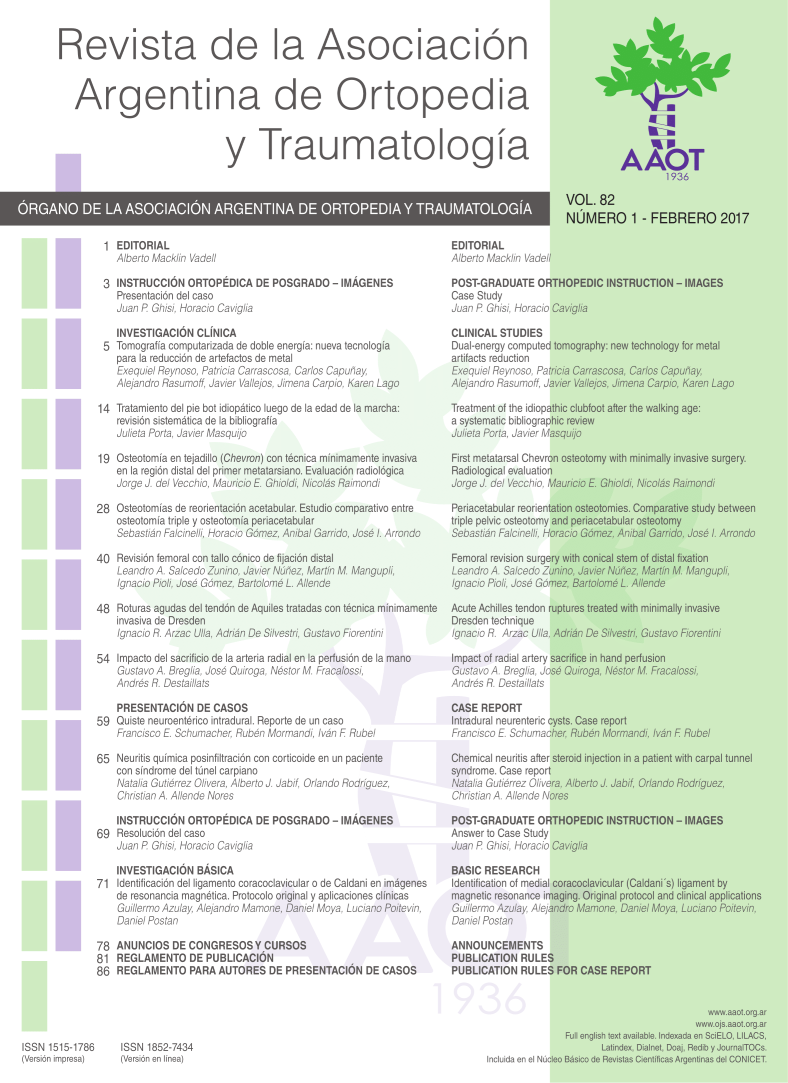Tratamiento del pie bot idiopático luego de la edad de la marcha: revisión sistemática de la bibliografía. [Treatment of the idiopathic club foot after the walking age: a systematic bibliographic review.]
Contenido principal del artículo
Resumen
Descargas
Métricas
Detalles del artículo

Esta obra está bajo licencia internacional Creative Commons Reconocimiento-NoComercial-CompartirIgual 4.0.
La aceptación del manuscrito por parte de la revista implica la no presentación simultánea a otras revistas u órganos editoriales. La RAAOT se encuentra bajo la licencia Creative Commons 4.0. Atribución-NoComercial-CompartirIgual (http://creativecommons.org/licenses/by-nc-sa/4.0/deed.es). Se puede compartir, copiar, distribuir, alterar, transformar, generar una obra derivada, ejecutar y comunicar públicamente la obra, siempre que: a) se cite la autoría y la fuente original de su publicación (revista, editorial y URL de la obra); b) no se usen para fines comerciales; c) se mantengan los mismos términos de la licencia.
En caso de que el manuscrito sea aprobado para su próxima publicación, los autores conservan los derechos de autor y cederán a la revista los derechos de la publicación, edición, reproducción, distribución, exhibición y comunicación a nivel nacional e internacional en las diferentes bases de datos, repositorios y portales.
Se deja constancia que el referido artículo es inédito y que no está en espera de impresión en alguna otra publicación nacional o extranjera.
Por la presente, acepta/n las modificaciones que sean necesarias, sugeridas en la revisión por los pares (referato), para adaptar el trabajo al estilo y modalidad de publicación de la Revista.
Citas
2. Van Gelder JH, Van Ruiten AG, Visser JD, Maathuis PG. Long-term results of the posteromedial release in the treatment of idiopathic clubfoot. J Pediatr Orthop. 2010 Oct-Nov;30(7):700-4.
3. Dobbs MB, Nunley R, Schoenecker PL. Long-term follow-up of patients with clubfeet treated with extensive soft-tissue release. J Bone Joint Surg Am. 2006 May;88(5):986-96.
4. Laaveg SJ, Ponseti IV. Long-term results of treatment of congenital club foot. J Bone Joint Surg Am 1980;62-A:23-31.
5. Ponseti IV. Congenital clubfoot. Fundamentals for treatment. Oxford: Oxford University Press; 1996.
6. Lourenço AF, Morcuende JA. Correction of neglected idiopathic club foot by the Ponseti method. J Bone Joint Surg Br. 2007 Mar;89(3):378-81.
7. Gul A, Sambanandam. Results of manipulation of idiopathic clubfoot deformity in Malawi by orthopedic clinical offers using the Ponseti Method: a realistic alternative for the developing world? J Pediatr Orthop. 2007 Dec;27(8):971;
8. Gargs S. Use of Ponseti method for recurrent clubfoot following posteromedial reléase. Indian Orthop. 2008. Jan;42(1):68-72.
9. Spiegel DA, Shrestha OP, Sitoula P, Rajbhandary T, Bijukachhe B, Banskota AK. Ponseti method for untreated idiopathic clubfeet in Nepalese patients from 1 to 6 years of age. Clin Orthop Relat Res. 2009 May;467(5):1164-70.
10. Yagmurlu MF, Ermis MN, Akdeniz HE, Kesin E, Karakas ES. Ponseti management of clubfoot after walking age. Pediatr Int. 2011 Feb;53(1):85-9.
11. Adeghehingbe, Oginni. Ponseti clubfoot management: changing surgical trends in Nigeria. Iowa Orthop. 2010 30:7-14.
12. Verma A, Mehtani A, Sural S, Maini L, Gautam VK, Basran SS, Arora S. Management of idiopathic clubfoot in toddlers by Ponseti's method. J Pediatr Orthop B. 2012 Jan;21(1):79-84.
13. Alves C, Escalda C, Fernandes P, Tavares D, Neves MC. Ponseti method: does age at the beginning of treatment make a difference?. Clin Orthop Relat Res. 2009 2009 May;467(5):1271-7.
14. Ayana B, Klungsøyr PJ. Good results after Ponseti treatment for neglected congenital clubfoot in Ethiopia. A prospective study of 22 children (32 feet) from 2 to 10 years of age. Acta Orthop. 2014 Dec;85(6):641-5. doi: 10.3109/17453674.2014.957085. Epub 2014 Sep 1.
15. Faizan M, Jilani LZ, Abbas M, Zahid M, Asif N. Management of Idiopathic Clubfoot by Ponseti Technique in Children Presenting After One Year of Age. J Foot Ankle Surg. 2014 Sep-Oct;54(5):967-72.
16. Khan SA , Kumar A. Ponseti´s manipulation in neglected clubfoot in children more than 7 years of age: a prospective evaluation of 25 feet with long-term follow up. J Pediatr Orthop B 2010 Sep:19(5):385-9.
17. Banskota B, Banskota AK. The Ponseti method in the treatment of children with idiopatic clubfoot presenting between five and ten years of age. Bone Joint J 2013 Dec;95-B(12):1721-5.
18. Agarwal A. Does initial Pirani score and age influence the number of Ponseti cast in children? Int Orthop 2014 Oct;38(10):2221.
19. Ford-Powell VA1, Barker S, Khan MS, Evans AM, Deitz FR. The Bangladesh clubfoot project: the first 5000 feet. J Pediatr Orthop. 2013 Jun;33(4):e40-4.
20. Wang YZ, Wang XW, Zhang P, Wang XS. Application of Ponseti method in patients older than 6 months with congenital talipes equinovarus. Beijing Da Xue Xue Bao. 2009 Aug 18;41(4):452-5.
21. Ponseti IV. Relapsing clubfoot: causes, prevention, and treatment. Iowa Orthop J. 2002;22:55-6.
22. Dobbs MB, Corley CL, Morcuende JA, Ponseti IV. Late recurrence of clubfoot deformity: a 45-year followup. Clin Orthop Relat Res. 2003 Jun;(411):188-92.
23. Gupta A. Evaluation of the utility of the Ponseti Method of correction of clubfoot deformity in a developing nation. Int Orthop 2008 Feb;32(1):75-9.
24. Morcuende JA. Management of congenital talipes equinovarus using the Ponseti method: a systematic review. J Bone Joint Surg Br. 2011 Sep;93(9):1160-4.
25. Horn BD, Davidson RS. Current treatment of clubfoot in infancy and childhood. Foot Ankle Clin. 2010 Jun;15(2):235-43.
26. Ponseti IV. Long-term results of treatment of congenital club foot. J Bone Joint Surg Am. 1980 Jan;62(1):23-31.
27. Masquijo J, Marchegiani S, Allende V. Diagnóstico prenatal del pie bot. Rev. argent. radiol. [online]. 2011, vol.75, n.4, pp. 335-339.
28. Derzsi Z, Gozar H, Gurzu S, Prisca R, Nagy OJ. Congenital clubfoot in children after walking age: management and evaluation of 41 feet with the dimeglio score. Clin Diagn Res. 2013 Dec;7(12):2841-3.
29. López Lobato R, Downey Carmona FJ, Farrington Rueda, DM. Complicaciones del método Ponseti: Edema de miembro por efecto ventana. Rev. Soc. Andal. Traumatol. Ortop. 2014; 31(2): 73-76.
30. Halanski M A. Ponseti Method Compared with Surgical Treatment of Clubfoot. A Prospective Comparison. J Bone Joint Surg Am 2010; 92(2): 270-277.

